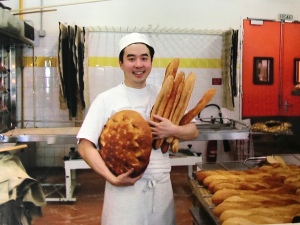
The first bread I learnt to bake was the recipe called “Le Pain Courant” (The Daily Bread).
The Ingredients of Recipe were:
1 Farine Panifiable (Bread-making-abled flour)
2 Water.
3 Salt
4 Fresh Yeast
5 Ameliorant de pain (Bread Improver)
Because of my language acquisition, and precision of french word employment, I would naturally be captured by the technicality of the words in the recipe.
“Farine Panifiable”; naturally I would think is a flour that has been conditioned to make bread.
“Ameliorant de pain”; something to improve the bread…
I did ask my trainer, what is “ameliorant de pain”? His answer, a typical french boulanger was, IS A BAKER’S INSURANCE. To ensure what? I wondered. And one day i had a chance to work in an “Ameliorant” company and I was selling bread additives. The sales argument was “consistency”. For decades and generations, many baker’s fear was inconsistency in their baked goods hence the dependency of baking aids and improvers.
To expand my knowledge on the field inwhich I am interested, Food Safety, I read a lot and extensively. Here is an extract of one publication written in February 1956 by The Food Protection Committee of the Food Nutrition Board, Washington D.C. (Some of the intentional additives mentioned in the report have been banned).
Wheat flour, in its natural, freshly milled state, has a yellowish tint due to the presence of small quantities of carotenoid and other natural pigments. when such flour is stored it slowly becomes whiter and undergoes an aging process involving reactions with oxygen of the air which causes it to yield a satisfactorily elastic, stable dough of enhanced breadmaking quality. Until about 40 years ago it was necessary for the miller to age flour so that the baker could produce the type of loaf demanded by the consuming public. It was then discovered that certain oxidising agents incorporated into flour in very small amount would bring about rapid improvement in its colour and breadmaking properties, thereby lessening the storage costs and the hazards of spoilage and infestation with insects and rodents associated with long storage. Some of the permissible agents, such as the oxides of nitrogen and benzoyl peroxide, exert only a bleaching action and are without influence on baking properties. Others, such as chlorine dioxide, nitrosyl chloride, and chlorine, have both bleaching and maturing or improving properties. Potassium bromate has only a maturing effect.
The maturing of flour is of much greater economic and practical significance than bleaching, which is practiced today chiefly because of the consumer preference for bread with creamy-white crumb. The flour milled from some threats requires very little oxidation, while that milled from wheat pf different varieties, or grown in other areas or in different crop years, may require substantially more oxidation to yield dough of satisfactory handling properties for mechanised baking and to produce bread of consistently goof quality. The maturing and bleaching agents help to smooth out the wide variations encountered in bread wheats and enable the miller to produce a standard and relatively uniform product.
Bread improvers employed by the baking industry contain a small amount if a solid oxidising substance, e.g., potassium bromate , potassium iodate and calcium peroxide, and inorganic salts such as ammonium chloride, ammonium sulphate, calcium sulphate, sodium chloride, mono or diammonium phosphate, and mono-, di-, or tricalcium phosphates which serve as yeast foods and dough conditioners. Their use helps assure vigorous and even fermentation of the dough and enable the baker to produce bread of uniform quality.
The use of maturing agents and oxidising improvers is of great economic value. It eliminates the costs and hazards associated with natural ageing and enables the baker to produce uniform baked goods with flour from new-crop wheat as soon as it is available. The widespread acceptance of these agents is illustrated by the fact that most of the bread and cake flours produced today are treated by the mills to improve their baking performance. In the production of quality cakes, highly refined, finely and uniformly granulated flour made from specially selected low protein wheat is required. This flour is bleached and matured with chlorine to produce tender cakes with colour, volume, and fine grain demanded by the consuming public.
The quantities of these oxidising agents required to obtain the desired improvement in baking performance are small, and if more than one is used, correspondingly less off each agent is necessary. Excessive treatment gives inferior baked products; thus the treatment is self-limiting.
Oh yes…the training institution where I was, is owned the miller.
